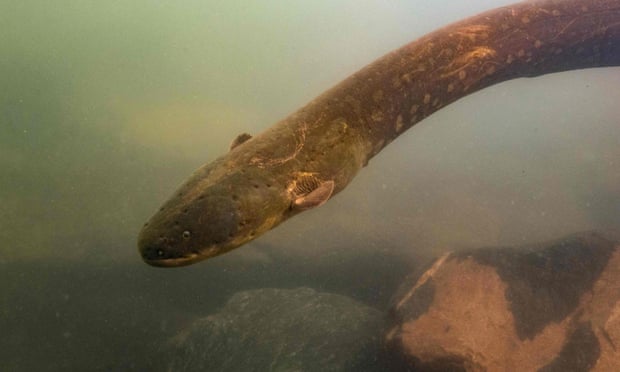Electrophorus voltai can deliver a jolt of 860 volts, much more than existing record of 650 volts
DNA research has revealed two entirely new species of electric eel in the Amazon basin, including one capable of delivering a record-breaking jolt.
The findings are evidence, researchers say, of the incredible diversity in the Amazon rainforest – much of it still unknown to science – and illustrate why it is so important to protect a habitat at risk from deforestation, logging and fires.
“In spite of all human impact on the Amazon rainforest in the last 50 years, we can still discover giant fishes like the two new species of electric eels,” said lead researcher C David de Santana, a zoologist working with the Smithsonian National Museum of Natural History.
The research “indicates that an enormous amount of species are waiting to be discovered in the Amazon rainforest, many of which may harbour cures for diseases or inspire technological innovations,” he said.
The electric eel, which is a kind of fish rather than an eel, inspired the design of the first electric battery.
For centuries, it was believed that a single species existed throughout the region known as Greater Amazonia, encompassing parts of countries including Brazil, Suriname and Guyana.
But as part of a project to better understand electric eels and map wildlife in remote parts of South America, de Santana and his team decided to test that theory.
At first glance, they found little visible difference between creatures collected from different parts of the Amazon basin, suggesting the fish were indeed part of a single species.Advertisement
But further analysis, including of DNA from 107 samples they collected, upended centuries of assumptions and revealed three species: the previously known Electrophorus electricus, along with Electrophorus voltai and Electrophorus varii.
And their research also uncovered another stunning result: E. voltai is capable of delivering a jolt of 860 volts – much more than the 650 volts previously recorded from electric eels – “making it the strongest bioelectricity generator known”.
The findings, published on Tuesday in the journal Nature Communications, theorise that the three species evolved from a shared ancestor millions of years ago.
The researchers found each of the three species had a clearly defined habitat, with E. electricus living in the Guiana Shield region, E. voltai in the Brazilian Shield, a highland further south, and E. varii inhabiting slow-flowing lowland Amazon basin waters.
And they suggest that the particularly strong electric shock that E. voltai can produce could be an adaptation to life in highland waters, where conductivity is reduced.
Electric eels use their shock tactics for a variety of reasons, including hunting prey, self-defence, and navigation. They generate electricity from three specialised electric organs that can emit charges of varying strengths for different purposes.
But the discovery of the new species raises the possibility that different types of eels may have evolved different ways of generating electricity, perhaps better suited to their diverse environments.
“Electric eel physiology inspired the design of Volta’s first electric battery, provided a basis … for treating neurodegenerative diseases and recently promoted the advance of hydrogel batteries that could be used to power medical implants,” de Santana said.
As the crisis escalates…
… in our natural world, we refuse to turn away from the climate catastrophe and species extinction. For The Guardian, reporting on the environment is a priority. We give reporting on climate, nature and pollution the prominence it deserves, stories which often go unreported by others in the media. At this pivotal time for our species and our planet, we are determined to inform readers about threats, consequences and solutions based on scientific facts, not political prejudice or business interests.
More people are reading and supporting The Guardian’s independent, investigative journalism than ever before. And unlike many news organisations, we have chosen an approach that allows us to keep our journalism accessible to all, regardless of where they live or what they can afford. But we need your ongoing support to keep working as we do.
The Guardian will engage with the most critical issues of our time – from the escalating climate catastrophe to widespread inequality to the influence of big tech on our lives. At a time when factual information is a necessity, we believe that each of us, around the world, deserves access to accurate reporting with integrity at its heart.
Our editorial independence means we set our own agenda and voice our own opinions. Guardian journalism is free from commercial and political bias and not influenced by billionaire owners or shareholders. This means we can give a voice to those less heard, explore where others turn away, and rigorously challenge those in power.
We need your support to keep delivering quality journalism, to maintain our openness and to protect our precious independence. Every reader contribution, big or small, is so valuable.



Wow, wonderful weblog format! How long have you ever been running a blog for?
you make running a blog glance easy. The total glance
of your site is wonderful, as smartly as the content! You can see similar
here sklep